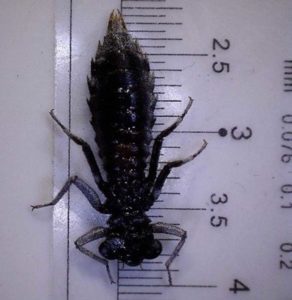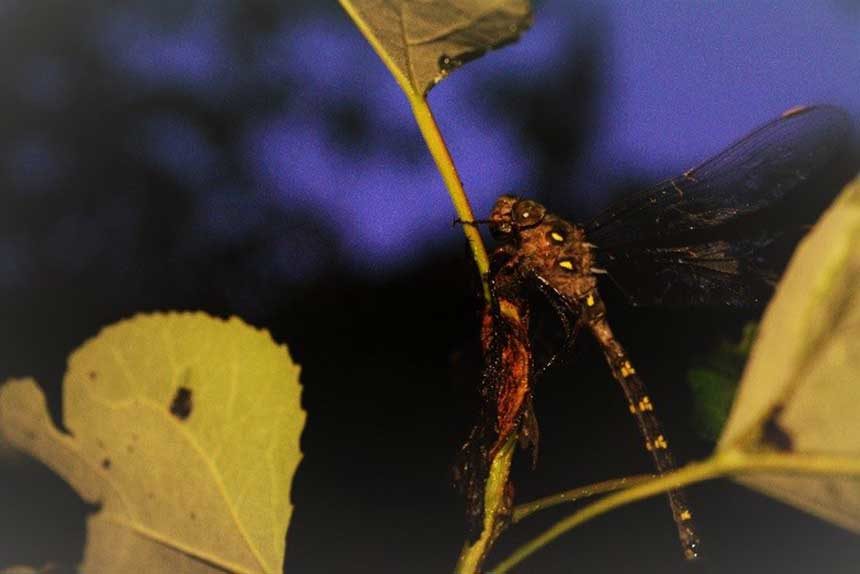Editor’s note: In honor of World Water Day (March 22nd annually) today’s Natural Selections post is focused on Odonata (dragonflies and damselflies) who call Tibbetts Brook and Van Cortlandt Lake home. Alex Byrne will introduce you to these fascinating creatures and share with you why you spend some time watching them in the Park.
It takes about half a day to get there, if you travel by Dragonfly.

By: Alex Byrne
Predators have always been a part of human culture and experience. Our intimacy with this act, read in tooth and claw, is a product of being predator and prey, hunter and the hunted. In some way the elevated status we have granted the predator in our species is a reflection of our own inherent and learned sensitivity to danger. The walls of caves have been manipulated through the use of saliva and plant fruits to display cave bears, dire wolfs and hunting human (Siva 2007). The Egyptians created gods out of birds of prey and the predatory perfecta, the felines (Pettigrew 2003). We have managed to take the big bad wolf and create 339 different dog breeds. In 1902 the US Army Medical Corps adopted the caduceus as an emblem which displays two snakes entwined around a staff, a behavior consistent with the mating behavior of serpents. The evidence for a predator centric society is abound, however a common theme in these predatory idols is the lack of entomological (insect) admiration. Most people do not spend their weekends in wetlands watching dragonfly’s hunt, but they should.
At the Friends of Van Cortlandt Park, we spend A LOT of time in the water and among the wetter terrestrial habitats within the park. A large focus of our Benthic Macro Invertebrate research has been describing all the living invertebrates within Van Cortlandt Lake and Tibbetts Brook. In freshwater ecosystems, predatory invertebrates can have a wide-ranging influence on the ecosystem. This includes driving the population dynamics of prey species and altering the flow of nutrients within the water and along the terrestrial riparian zones (Knight et al 2005). In Tibbetts Brook and Van Cortlandt Lake, one group of aquatic predatory invertebrates are turning out to be quite diverse; the odonata, commonly referred to as dragonfly’s and damselfly’s. Odonates start life as an aquatic nymph, which is the life stage FVCP staff search for amongst the waters, aquatic vegetation and aquatic sediments. In New York State, 194 species of dragonfly and damselfly have been recorded (White et al 2010). Between the period of 2005 and 2009, 63 odanate surveys were performed in the Bronx producing 29 identified species with possibly a handful more still left to be found (White et al 2010). As more odonates are described from Van Cortlandt Lake and Tibbetts Brook, we are beginning to realize the integral role of the Lake and Brook in the Bronx in maintaining one of the most diverse odonate habitats in New York City.
An adult Aeshnidae. Photo by Alex Byrne.
One taxonomic family of dragonfly’s, Aeshnidae, commonly referred to as darners, have been observed hunting in Van Cortlandt Lake and its behavioral dominance, large nymph size, active hunting style and variable diet make it likely a strong driver of community structure where it is abundant. Our efforts thus far have recovered two different genera of darners, Anax and Aeshna. The Anax specimen is hypothesized to be the green darner species Anax Junius, known for making long southward migrations that can cover 20km in single pushes (Russel et al 1998). Both genera of Aeshnidae are typically sampled from macrophytes (aquatic vegetation) in shallower areas of the lake. Odonates in the family Aeshnidae are supreme hunters that can take on prey ranging from zooplankton to small fish and amphibian tadpoles as well as other dragonfly naiads. In addition, experimental evidence has demonstrated that Aeshnidae become more efficient predators at higher water temperatures suggesting that climate warming may have a significant impact on the functionality of odonate based food webs (Eck et al. 2014).
Evidence based on where we find Aeshnidae in Van Cortlandt Lake associated with macrophytes suggests that management of invasive macrophytes and the introduction of multiple native species can benefit this group. As a function of Aeshnidae carnivory and piscivory (fish eater) and the capacity of heavy metals like mercury to bio accumulate in fat tissue, Aeshnid odonates accumulate some of the largest concentrations of mercury, making them an ideal bio indicator of heavy metal concentration in aquatic ecosystems that can be used in the parks waters as pollution sentinels (Riva-Murray 2011). Aeshnids are also prolific fliers and hunters after they emerge from the water into their adult form. After what is referred to as an incomplete metamorphosis, multiple species of darners will gather in open canopy spaces in fields or along river banks to hunt in large groups, typically composed of multiple species. The Parade Grounds of Van Cortlandt are no exception and late summer is always a good time to observe this foraging phenomenon. Future studies of this group of odonates in Van Cortlandt Lake and Tibbetts Brook will be concerned with exactly what are the driving effects of Aeshnids on the surrounding community and are community structures less or more predictable in the presence of Aeshnid odonates.
Eck, B., Byrne, A., Popescu, V. D., Harper, E. B., & Patrick, D. A. (2014). Effects of water temperature on larval amphibian predator-prey dynamics. Herpetological Conservation and Biology, 9(2), 302-308.
Siva, R. (2007). Status of natural dyes and dye-yielding plants in India. Current science, 916-925.
Pettigrew, T. J. (2013). A History of Egyptian Mummies: And an Account of the Worship and Embalming of the Sacred Animals by the Egyptians. Cambridge University Press.
Russell, R. W., May, M. L., Soltesz, K. L., & Fitzpatrick, J. W. (1998). Massive swarm migrations of dragonflies (Odonata) in eastern North America. The American Midland Naturalist, 140(2), 325-342.
White, Erin L., Jeffrey D. Corser, and Matthew D. Schlesinger. 2010. The New York dragonfly and damselfly survey 2005-2009: Distribution and status of the odonates of New York. New York Natural Heritage Program, Albany, New York. 424 pp.
Riva-Murray, K., Chasar, L. C., Bradley, P. M., Burns, D. A., Brigham, M. E., Smith, M. J., & Abrahamsen, T. A. (2011). Spatial patterns of mercury in macroinvertebrates and fishes from streams of two contrasting forested landscapes in the eastern United States. Ecotoxicology, 20(7), 1530-1542.
Knight, T. M., McCoy, M. W., Chase, J. M., McCoy, K. A., & Holt, R. D. (2005). Trophic cascades across ecosystems. Nature, 437(7060), 880.


